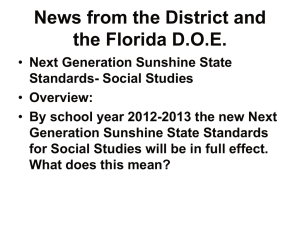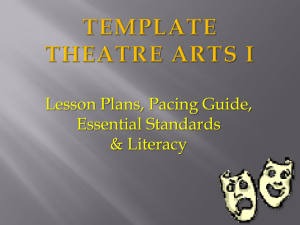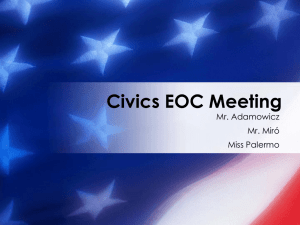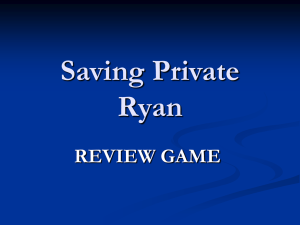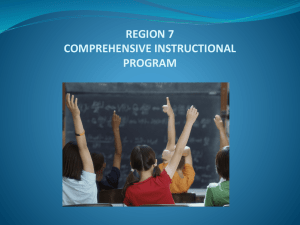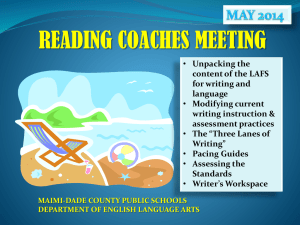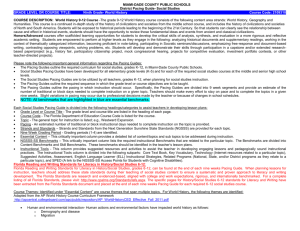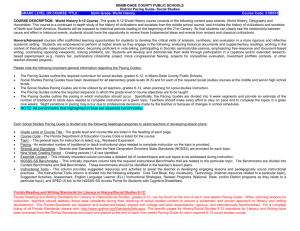Understanding the Pacing Guide for Effective Lesson Planning file
advertisement
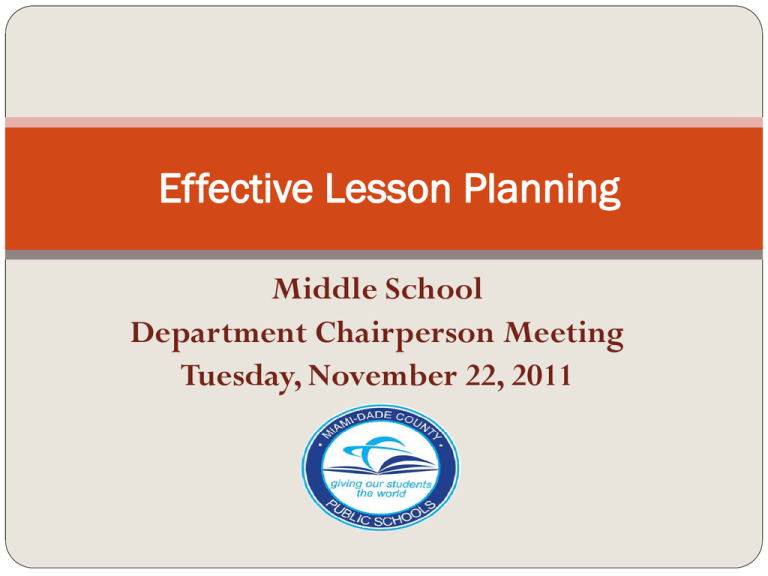
Effective Lesson Planning Middle School Department Chairperson Meeting Tuesday, November 22, 2011 Before Planning: How do our students retain knowledge? Instructional Method Average Retention / Rate of Knowledge or Skill Lecture 5% Retained Reading Textbooks, etc. 10% Retained Audio-Visual 20% Retained Demonstration/Modeling 30% Retained Discussion Group 50% Retained Practice by Doing 75% Retained Teach others/Immediate Use of Learning 90% Retained Taken from NTL Institute for Applied Behavioral Science Lesson Planning…What to Focus On… Lessons that encourage discussions, practice by doing, and teaching others. More depth and rigor… -Webb’s Depth of Knowledge -Social Studies Task cards integration -Primary Source document analysis -Writing activities Using the recommended Social Studies lesson plan template Following the Pacing Guides All information can be found at socialsciences.dadeschools.net Social Studies Lesson Plan Template Teacher’s Name: Employee Number: School: Work Location Number: •Title: (topic/specify grade level) •Overview - Big Ideas: Enduring Understandings – (It is important for student to understand this because…….) (ESSENTIAL CONTENT) Essential Questions – (What provocative questions will you use to foster inquiry, understanding and transfer of learning?) •Lesson Objectives: Standards - (Next Generation Sunshine State Standards) •Key Vocabulary: What key knowledge and skills will students acquire as a result of this lesson? What will students be able to do as a result of such knowledge and skills? Both formative and summative assessments are included •Materials Needed: (Include primary sources you will use in this lesson) •Steps to Deliver the Lesson: A detailed, step by step description of how to deliver the lesson and achieve the lesson plan objectives. These should be sufficiently clear so that another teacher could implement the lesson without guidance. •Specific Activities: (From Guided to Independent) List and/or describe the activities designed to facilitate the gradual release of teacher responsibility, from teacher-led to independent •Differentiated Instruction Strategies: Describe how you will accommodate a variety of student learning needs, remediation strategies as well as enrichment strategies. •Technology Integration: Describe activities incorporating technology; e.g., address lesson content through online resources. •Lesson Closure: Description of methods to draw ideas together, review concepts, etc Lesson Planning using the NGSSS-SS Pacing Guide Pacing guides for all grade levels can be found at the Social Sciences district website at: http://socialsciences.dadeschools.net on the main page, under title: NGSSS-SS Pacing Guides Pacing guides are divided into the four nine week grading periods. Pacing guides are the driving force of our instruction and our lesson planning. NGSSS-SS Pacing Guide Format Each Social Studies Pacing Guide is divided into the following headings/categories to assist teachers in developing lesson plans: Grade Level or Course Title - The grade level and course title are listed in the heading of each page. Course Code - The Florida Department of Education Course Code is listed for the course. Topic - The general topic for instruction is listed; e.g., Westward Expansion. Pacing - An estimated number of traditional or block instructional days needed to complete instruction on the topic is provided. Strands and Standards – Strands and Standards from the Next Generation Sunshine State Standards (NGSSS) are provided for each topic. Nine Week Grading Period - Grading periods (1-4) are identified. Essential Content – This critically important column provides a detailed list of content/topics and sub topics to be addressed during instruction. NGSSS-SS Benchmarks – This critically important column lists the required instructional Benchmarks that are related to the particular topic. The Benchmarks are divided into Content Benchmarks and Skill Benchmarks. These benchmarks should be identified in the teacher’s lesson plans. Instructional Tools - This column provides suggested resources and activities to assist the teacher in developing engaging lessons and pedagogically sound instructional practices. The Instructional Tools column is divided into the following subparts: Core Text Book, Key Vocabulary, Technology (Internet resources related to a particular topic), Suggested Activities, Assessment, English Language Learner (ELL) Instructional Strategies, Related Programs (National, State, and/or District programs as they relate to a particular topic), and SPED (A link to the NGSSS-SS Access Points for Students with Cognitive Disabilities). NGSSS-SS Pacing Guide Format Introduction/Header: Topic 7: Influencing the Government Pacing: Traditional 8 Days Block: 4 Days Strand(s) and Standard(s): Civics and Government: (Standard 2: Evaluate the roles, rights, and responsibilities of United States citizens, and determine methods of active participation in society, government and the political system) Geography: (Standard 4: Understand the characteristics, distribution, and migration of human populations) NGSSS-SS Pacing Guide Format Essential Content • Development of American Political Party NGSSS-SS Benchmarks Content Benchmarks: o Origins of Our Two-Party System: (i.e., Jeffersonians v. Hamiltonians) SS.7.C.2.8: Identify America's current political parties, and illustrate their ideas about government. o Democrats oRepublicans oThird Parties Skill Benchmarks: oOther Party Systems: (One Party, Two Party, Multi-Party systems) LA.7.1.6.2: The student will listen to, read, and discuss familiar and conceptually challenging text. Mandates Instructional Tools Core Text Book: TBA Vocabulary/ Identification: Political party, two-party system, third party, etc. Technology: Center for Civic Education http://www.civiced.org/ White House Website: Elections and voting http://www.whitehouse.gov/our-government/elections-and-voting Ben’s Guide to US government: The Election Process Suggested Activities: Have students compare and contrast the two major political parties (democrats and republicans) using a Venn Diagram. Have students research the platform of a modern political party and write a 5-paragraph expository essay explaining the party’s beliefs. What do I write on my lesson plans? The Essentials from the Pacing Guide: 1. General student learning objectives ( from standards) 2. Essential Topics/Subtopics (your covered content) 3. Benchmarks (from pacing guide) – performance objectives Example: SS.912.A.2.1: Review causes and consequences of the Civil War. 4. Instructional Tools Vocabulary, Technology, Activities -----------------------------------------------------5. Detailed steps in delivering instruction It is better to overplan!!! 1. Student Objectives (from standards) Strand(s) and Standard(s): Civics and Government: (Standard 2: Evaluate the roles, rights, and responsibilities of United States citizens, and determine methods of active participation in society, government and the political system) Geography: (Standard 4: Understand the characteristics, distribution, and migration of human populations) The student will be able to evaluate the roles, rights, and responsibilities of United States citizens, and determine methods of active participation in society, government and the political system. The student will be able to understand the characteristics, distribution, and migration of human populations. 2. Essential Topics/Subtopics (your covered content) Essential Content • Development of American Political Party o Origins of Our Two-Party System: (i.e., Jeffersonians v. Hamiltonians) o Democrats o Republicans o Third Parties o Other Party Systems: (One Party, Two Party, Multi-Party systems) 3. Benchmarks (from pacing guide) NGSSS-SS Benchmarks Content Benchmarks: SS.7.C.2.8: Identify America's current political parties, and illustrate their ideas about government. Skill Benchmarks: LA.7.1.6.2: The student will listen to, read, and discuss familiar and conceptually challenging text. 4. Instructional Tools Vocabulary, Technology, Activities Vocabulary/ Identification: Political party, two-party system, third party, etc. Technology: Center for Civic Education http://www.civiced.org/ White House Website: Elections and voting http://www.whitehouse.gov/our-government/elections-and-voting Activities: Have students compare and contrast the two major political parties (democrats and republicans) using a Venn Diagram. Have students research the platform of a modern political party and write a 5-paragraph expository essay explaining the party’s beliefs. 5. Detailed Description of Procedures for the Lesson (90 min Block Planning) Steps to Deliver Instruction o Do Now / Bell Work – 5 min o Direct/Whole Group Instruction – 20 min o Differentiated Instruction – 20 min o Cooperative Learning – 25 min o Individual Learning – 10 min o Assessment / Extension Activities / Home Learning Assignment – 10 min 5 minutes Do Now or Bell Work• Quote analysis • Critical thinking question • Vocabulary development • Cause & effect analysis • Journal writing Do Now or Bell Work- is a daily instructional activity that allows the learner to get prepared for the day’s lesson by either connecting ideas from a previous class or providing insight into objectives that will be met for the day’s lesson. 20 minutes Direct /Whole Group Instruction • Lecture • Class discussions • Text-based learning • Scaffolding strategies • Critical thinking strategies Direct/Whole Group Instruction- during this time, instruction is teacher-directed, focusing on appropriate learning strategies to build comprehension of content, increase vocabulary, and analyze cause and affect relationships. This is where students are informed of content and skills necessary to meet the objectives of the day’s 20 minutes Differentiated Instruction • Independent reading • Teacher directed small group •Computer centers Differentiated instruction- provides focused intervention based on students’ specific needs. 25 minutes Cooperative Learning • Graphically display information • Content reporting • Project-based learning • Research projects Cooperative Learning- includes a number of strategies whereby students help each other to learn content, acquire knowledge, build skills, and/or analyze information thus building upon knowledge acquired during direct instruction and/or differentiated instruction. 10 minutes Individual Learning • Analyze text • Create a chart/graphic organizer • Take quiz Individual Learning- includes various activities/ strategies where students must perform on an individual basis in order for the instructor to assess at what level learning has taken place based on the lesson. 10 minutes Assessment/Extension Activities/Home Learning • Review lesson objectives and check for student understanding • Connect today’s lesson with what will occur during the next session. Assessment/Extension Activities/Home LearningExplanation of home-learning/extension activity and assessment of lesson objectives. PACING GUIDE + LESSON PLANNING = GETTING READY FOR THE CIVICS END OF COURSE TEST How to use the pacing guide to lesson plan (for Civics tested benchmarks) Current: Topic 7 – Influencing the Government Tested Benchmarks for Topic 7: SS.7.C.2.10: Examine the impact of media, individuals, and interest groups on monitoring and influencing government. SS.7.C.2.11: Analyze media and political communications (bias, symbolism, propaganda). SS.7.C.2.13: Examine multiple perspectives on public and current issues. Look at Essential Content Column (first column) and cover topics in your instruction Public Opinion: (Mass Media, Print Media, Electronic Media, Public Agenda, Watch Dog Role) Measuring Public Opinions: (Public Opinion Polls) Interest Groups: Economic Interest Groups (e.g., Labor Unions), Public Interest Groups, Social Interest Groups Public Policy: Election Activities, Challenging Laws in Court, Lobbyists Propaganda: Various Techniques How to use the pacing guide to lesson plan (for Civics tested benchmarks) Integrate Vocabulary, Technology, and Suggested Activities from the Pacing Guide: Have the students plan a talk radio program with a political message. Have students form groups with the following roles: talk show host, government official and a callin listener. The students can also include a commercial break supporting the political message. Have students create a PowerPoint for an interest group or influential person from an interest group such as Cesar Chavez, A. Philip Randolph, etc. Have students write a job description for a professional lobbyist. The description should include the skills and experience required for the job as well as a list of duties Have students design graphics and illustrations that depict the methods used by special interest groups to influence the public such as television advertising, newspaper articles, bumper stickers, flyers, etc. Design a detailed lesson with procedures (using textbook, other resources, warm up, lesson, activities, differentiated instruction, assessment, closure, etc. ) How to use the pacing guide to lesson plan (for Civics tested benchmarks) Adding it all up from the pacing guide to cover each tested benchmark! Look at Current Topic and Tested Benchmarks +cover each essential content + integrate vocabulary, technology, suggested activities + design a lesson with detailed instructions and procedures (using textbook, other resources, warm up, lesson, activities, differentiated instruction, assessment, closure, etc. ) = FINAL RESULT: Tested benchmark is completely covered by student = SUCCESS! Getting our Students Prepared! You!!! Spreading the Information and upcoming PD Elementary Lessons – Civic Integration – Grades 3, 4,5 Middle School Lessons – Civic Integration – Grade 6 7th Grade Pacing Guide Forthcoming: o Highlighted tested Benchmarks (on pacing guide) o Lessons for tested Benchmarks (on pacing guide) o Pre/Post Assessments (Edusoft) • Use pacing guide to lesson plan (integrate) as an instructional tool. The pacing guide is not your lesson plan but your guide for instruction. Finally, when lesson planning for the Civics EOC test, think of this… Regarding Cognitive Complexity Breakdown Development of the Civics items by Cognitive Complexity will be spread out as noted below based on the recommendations of the Civics Content Advisory Committee: Content Low Moderate High Civics 15% - 25% 45% - 65% 15% - 25% Examples of Civics Activities Across Cognitive Complexity Levels Low Complexity Moderate Complexity High Complexity Identify or recall common historical events, actions, personalities, or concepts. Apply or infer cause-andeffect relationships. Solve or predict the outcome of a problem. Use a chart, table, diagram, graph, or image to recall or recognize information. Identify outcomes of particular cause-andeffect relationships. Generalize or draw conclusions when presented with historical or contemporary information. Identify characteristics of a particular group, place, or event. Identify the significance of historical or contemporary events, actions, personalities, or concepts. Predict a long-term result, outcome, or change within society. Questions/Concerns Thank you for your attention. Guillermo Ramos, Curriculum Support Specialist gramos1@dadeschools.net 305-995-1781

